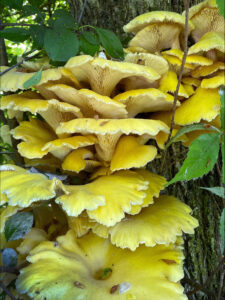
Golden oyster mushrooms grow on a dead American elm tree in Green County in June 2025. / Photo Credit: Wisconsin DNR
By Kyoko Scanlon, DNR Forest Pathologist
Kyoko.Scanlon@wisconsin.gov or 608-235-7532
Golden oyster mushrooms (Pleurotus citrinopileatus) have eye-catching bright-yellow caps with branch-like white gills. Recently, more people have been noticing these gorgeous-looking clusters of mushrooms growing on trees in Wisconsin, especially in southern Wisconsin.
These mushrooms, prized for culinary delicacy, are native to eastern Asia. However, they are found in forests throughout the Midwest and northeastern United States, including Wisconsin.
It is believed that the golden oyster mushroom was imported into North America in the early 2000s and escaped into forests around 2010. Since then, their presence has ballooned and spread rapidly. The first record of this fungus in Wisconsin was found in Madison in 2014.
It’s great that these delicious mushrooms are growing in populations in our forests, right? Not really. Recent research studies show that these non-native mushrooms are displacing native fungal communities. According to new research from the University of Wisconsin-Madison’s Aishwarya Veerabah, trees with golden oyster mushrooms are populated with fewer fungi and different fungal communities compared to trees without them.
Based on the rapid rate of spread during the last decade, experts are concerned that this fungus could dramatically and negatively impact native fungal communities and change forest ecosystems.
Golden oyster mushrooms are easy to cultivate; growing kits are sold online. Spores produced from these non-native mushrooms will be carried by air to nearby forests. It is encouraged to cultivate native mushrooms to avoid the risk of introducing non-native fungi into our forests.
